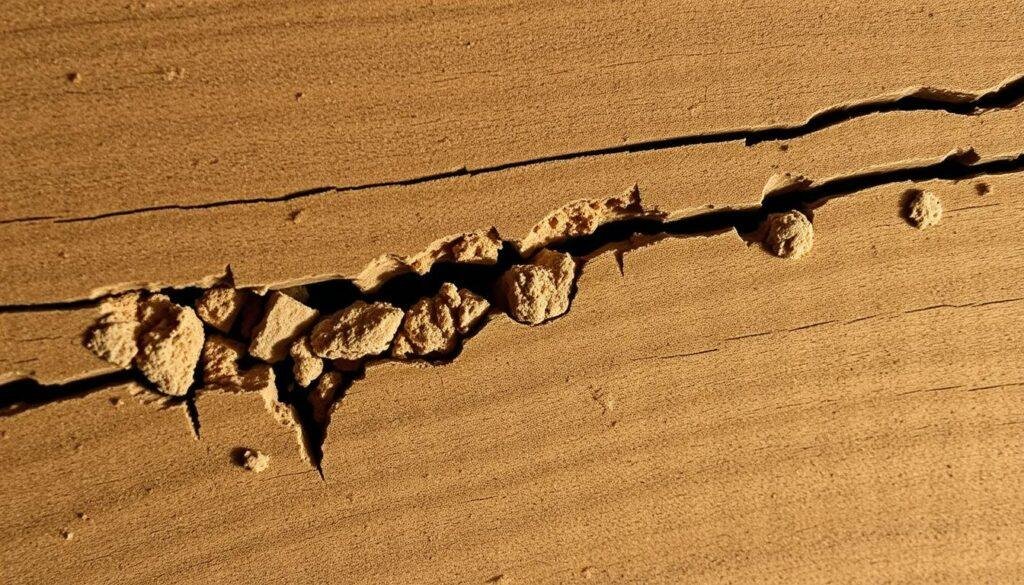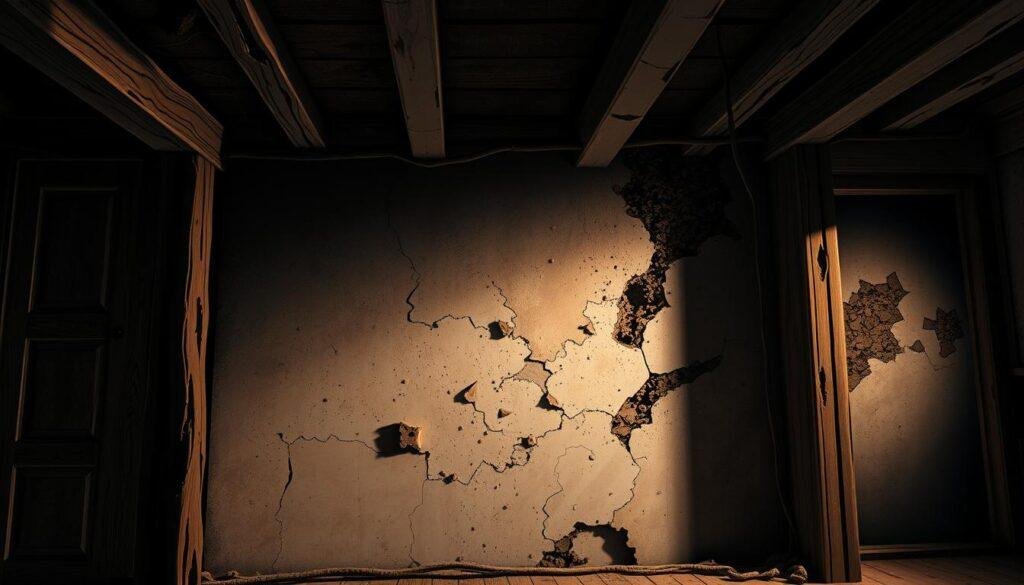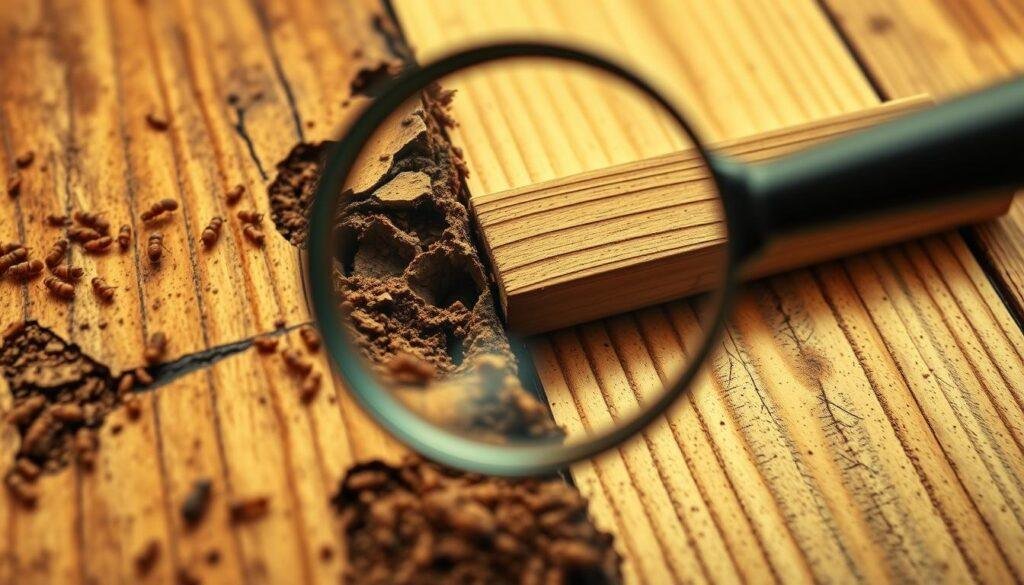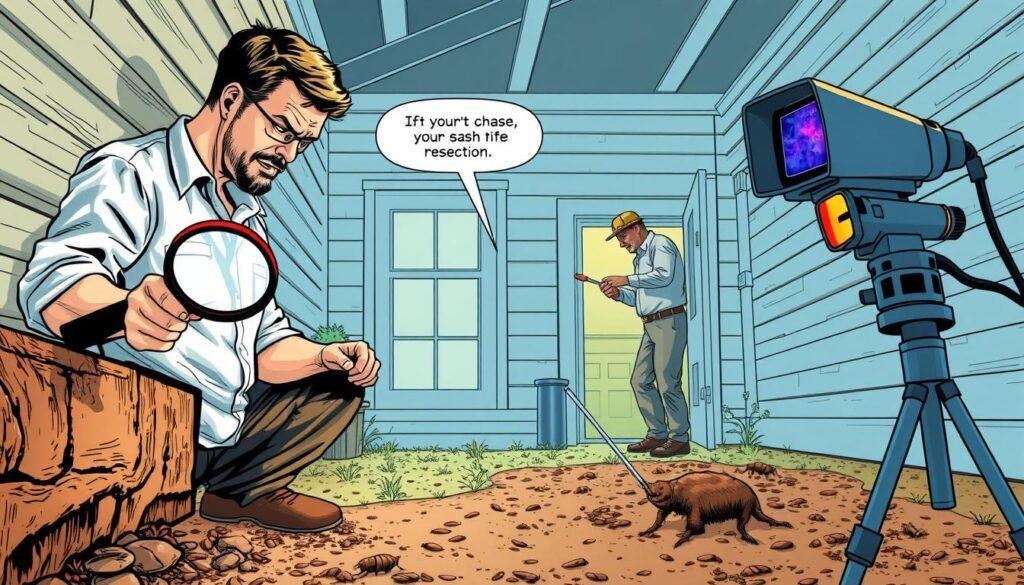
Dealing with Subterranean Termites in Florida: Signs, Damage, and Solutions

In the United States, termites cause about $5 billion in property damage yearly. This fact is crucial for Florida homeowners due to the state's warm and humid climate. It's perfect for subterranean termites. Recognizing termite damage signs early makes a big difference. It can mean minor repairs instead of extensive, expensive fixes.
Subterranean termites love to eat cellulose. This is found in wood and plant materials, which makes our homes a target. In this article, we'll look at important signs of termite damage. We'll show how to spot these signs early and effective ways to protect your home from these pests.
- Understanding Subterranean Termites in Florida
- Common Signs of Termite Damage
- Visual Indicators of Infestation
- The Importance of Early Detection
- Recognizing Hidden Damage
- Methods for Inspecting Your Property
- Treatment Options for Subterranean Termites
- Preventative Measures to Consider
- Understanding Termite Behavior in Florida
- Encouraging a Termite-Free Environment
- FAQ
Understanding Subterranean Termites in Florida
Subterranean termites cause a lot of damage in Florida. Florida's wet climate helps them grow. They form colonies underground that can really harm buildings and nature if not controlled.
Overview of Subterranean Termites
Subterranean termites live underground. These include Formosan and Reticulitermes species. They eat wood and can damage buildings badly.
Knowing their life cycle helps manage them. They grow fast and build big colonies. They may even compete for food and space.
Florida's Climate and Its Impact on Termites
Florida's weather is ideal for termites. Moisture attracts them. The state has lots of termite colonies which increases infestation risk.
Understanding these conditions helps homeowners protect their homes. They can take steps to lower the risk from termites.
Common Signs of Termite Damage
Homeowners must watch out for termite damage signs, which can be easy to miss. Catching these signs early can prevent costly repairs. Knowing what to look for is crucial for keeping your home safe.
Swarmers and Winged Termites
One clear sign of termite trouble is seeing swarmers, or winged termites. These termites show up in swarms, especially in spring. They are drawn to lights and often found near windows or lamps. Seeing them means termites are nearby and it's urgent to check for damage.
Mud Tubes and Soil Tunnels
Termites build mud tubes, which are pencil-sized mud tunnels, to travel from underground to your house. Look for these tunnels on walls or foundations. If you see mud tubes, it means termites might be infesting your home. This discovery warrants a closer look for more signs of infestation.
Hollowed or Indented Wood
If wood in your house seems hollow or has indents, termites might be feasting on it. These signs can look like a honeycomb, showing active wood destruction. Regular checks for these indicators are key to stopping termite damage early.

Visual Indicators of Infestation
It's key for homeowners to keep an eye out for signs of termite damage. Recognizing these signs early can help avoid bigger problems. Look for certain clues that could mean termites are around, needing a closer look.
Peeling or Bubbling Paint
Peeling or bubbling paint is a big clue. It might look like water damage at first. But, it can actually point to termites working underneath. If you see this, it might mean your wood structures are under attack.
Squeaky or Loose Floorboards
Floorboards that squeak or feel loose can warn of termites. They eat into wooden parts, weakening your home's structure. If you notice this, it could signal serious termite damage below.
The Importance of Early Detection
It's vital to catch termite infestations early. Many homeowners don't notice the early, subtle signs of termites. Seeing these signs early lets you act fast, preventing major harm to your home and saving lots of money on repairs.
Preventing Extensive Damage
Catching termite issues early is key to stopping damage. Termites can cause serious harm quickly, putting your home at risk. By doing regular checks and being watchful, you can spot problems early. This not only keeps your home strong but also makes it safer.
Cost Implications of Late Intervention
Ignoring termites can make costs skyrocket. Once they settle in, getting rid of them and fixing the damage costs a lot. If you let it go too far, insurance might not cover the big repairs. That's why finding problems early and taking steps to prevent them saves money now and later on.

Hidden termite damage can be insidious, often concealed within walls and structural elements for years. Homeowners need to be vigilant in recognizing termite damage, as early detection can save significant costs and prevent further structural issues. Areas such as attics and basements are particularly vulnerable, given the moisture that tends to accumulate in these spaces. Observing for specific signs can lead to prompt action.
Inside Walls and Structural Elements
Termites often navigate through walls, leaving little evidence of their presence, which makes recognizing termite damage challenging. Signs to look for include tiny entrance holes in wood and drywall, accompanied by droppings that may resemble sawdust. Regular inspections can expose hidden termite damage before it becomes severe.
Signs in Attic and Basement Areas
The attic and basement are crucial areas for identifying termite indicators. Homeowners should check for:
- Small holes in wooden beams or joists
- Soft or damaged wood that sounds hollow when tapped
- Discoloration or sagging in ceilings and walls
- Presence of termite wings scattered on the floor
Recognizing these signs is essential for taking appropriate action against hidden termite damage, ensuring that homes remain structurally sound.
Methods for Inspecting Your Property
Checking your property often is key to avoid termite problems. By using different inspection techniques, you can spot issues early. This early detection is crucial for the condition of your wood structures.
DIY Inspection Tips
Doing a DIY inspection means paying close attention. Start by looking around outside for signs like mud tubes or wood damage. A flashlight is handy for dark spots and deep corners. This makes sure you don't miss anything.
Using a screwdriver to tap on wood can show if it's hollow from termites. It's also important to check if places are too damp since termites love moisture. Inspecting your home every few months can stop big problems later on.
When to Call a Professional
Sometimes, a DIY check isn't enough. If you find a lot of damage or think there's a big termite problem, it's time for expert help. Pest control experts have the right tools and know-how. They do detailed checks and know exactly what to do.
Their knowledge helps find termites you can't see. This gives homeowners a sense of security.

Treatment Options for Subterranean Termites
Dealing with termites includes various effective treatments. These range from chemicals to advanced bait systems. Knowing these options helps homeowners pick the right approach.
Chemical Treatments and Barriers
Chemical barriers aim to protect by making a zone in the soil around your home. These barriers kill termites that touch or eat them, blocking their entry. Experts use chemicals like fipronil or imidacloprid to control termite populations well.
Keeping up with maintenance and reapplication is key. This ensures your home stays protected against more termites.
Baiting Systems Explained
Termite baiting systems, like Sentricon, target termite colonies directly. They use bait stations filled with slow-acting poisons around your home. Termites eating the bait then spread it in their nest, killing the entire colony. Bait systems also lure termites away, reducing harm to your home.
With regular checks, homeowners can keep these systems working well for a long time.
Preventative Measures to Consider
It's very important to take steps early on to protect your home from termites. Adding termite prevention to your regular home care can greatly decrease the chance of damage. Important measures include keeping up with house repairs and yard care.
Regular Home Maintenance
To avoid termites, it's crucial to maintain your home well. Begin by fixing leaks to avoid moist areas, where termites love to live. Make sure to clean your gutters and downspouts often. This helps keep water away from your house's base. Also, using treated lumber outside can help keep termites away. Let’s look at some key tips for home upkeep:
| Home Maintenance Tips | Purpose |
|---|---|
| Fix leaks | Reduces moisture levels |
| Clean gutters | Prevents pooling water |
| Use treated wood | Creates a barrier against termites |
| Seal cracks and crevices | Prevents termite entry |
Landscaping Tips to Reduce Risk
When it comes to your yard, planning is key to keep termites away. Make sure to keep plants and mulch at least 18 inches from your home. This makes it harder for termites to get inside. Also, store wood piles far from your house. Good landscaping can also help avoid too much moisture near your home. Here are some landscaping strategies to consider:
- Maintain a buffer zone of rocks or gravel between landscaping and foundation.
- Install proper drainage systems to direct water away from the home.
- Avoid planting trees or shrubs close to the foundation.
- Regularly inspect decorative wood features for any signs of damage.
Understanding Termite Behavior in Florida
Exploring how termites behave gives us clues to stop them before they become a problem. It's important to understand their lifecycle. This includes various stages that impact how these pests act and live together. Knowing this helps us fight them off in Florida’s unique weather.
Lifecycle of Subterranean Termites
Termites start as eggs and then become nymphs before reaching adulthood. Each stage is crucial for the growth of their colony. A colony has workers, soldiers, and reproducers. Knowing about these stages can help homeowners spot when they might get termites. This lets them act early.
Factors Contributing to Infestations
Several things make Florida a hotspot for termites. Important factors include:
- Moisture Levels: Subterranean termites love wet places, so keeping areas dry is key.
- Food Sources: They eat wood and similar materials, so cutting off their food can keep them away.
- Climate Conditions: Florida's warm, damp weather is perfect for termites, so homeowners need to keep watch.
Understanding these factors can help people protect their homes from termites.
Encouraging a Termite-Free Environment
Keeping your home free from termites is crucial, especially in Florida where they're common. Partnering with skilled pest control pros is one of the best ways to keep your property safe. These experts help homeowners to take early action and create a detailed plan against termites, tailored to their needs.
Partnering with Pest Control Experts
Professional pest services don't just find infestations, but they also prevent them. Regular checks by these professionals can reveal hidden termite signs early. This ensures quick action to avoid major damage. By working closely with trusted pest experts, homeowners learn how to keep their homes termite-free. They also get access to safe, targeted treatments.
Getting help from pest control experts is key to fighting subterranean termites. Their support helps make your home more resistant to termite attacks. This protects your property now and in the future.
FAQ
What are the common signs of termite damage?
How can I detect termite damage in my home?
When should I call a pest control professional for termites?
What treatment options are available for termite infestations?
How can I prevent termite infestations in my home?
What are the indicators of a termite infestation?
How often should I inspect my home for termites?
Why is early detection important for termite damage?
Whether you’re tackling a single rogue ant or battling a full-scale termite invasion, our guide has you covered. Save Dealing with Subterranean Termites in Florida: Signs, Damage, and Solutions to your bookmarks and visit often—we refresh tips, treatment methods, and product reviews throughout 2025 so you can keep every pest problem under control the moment it appears.

